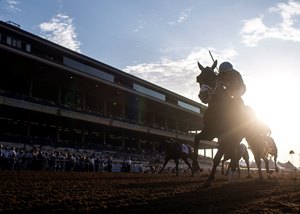Del Mar Reports Strong Safety Numbers at Summer Meet


With the national spotlight on equine safety and welfare, Del Mar concluded its 80th summer meeting Sept. 2 as the safest major racetrack in the United States for the second consecutive year based on available racing numbers.
After introducing a comprehensive series of safety programs in 2017 and 2018, Del Mar expanded its safety measures this summer, including additional pre-race veterinary observation protocols and an independent panel of veterinarians and racing officials to review all horses scheduled to race. There was not a single serious injury during racing this summer, an unprecedented feat. Last year, The Jockey Club's Equine Injury Database ranked Del Mar as the safest major racetrack in the U.S.
"Without a doubt, this is the most gratifying meet I have ever been part of," said Del Mar Thoroughbred Club CEO Joe Harper. "Given the current climate, especially after the first half of the year in Southern California, we had three goals this summer: continuation of our exemplary safety record, to provide stability and a dependability to racing in California, and to offer a consistent, five-day-a-week schedule that would reward fans and horsemen alike.
"With a wonderful display of teamwork from our owners, trainers, jockeys, vets, track personnel, and the CHRB, we accomplished these goals in exceptional fashion."
Del Mar officials said it was an important meeting following the equine safety issues earlier this year at Santa Anita Park.
"We are very proud of what we achieved this summer," said Del Mar executive vice president of racing Tom Robbins. "To average eight runners per race, in less than optimal circumstances, was remarkable. Credit goes to racing secretary David Jerkens, our track crews, led by Dennis Moore and Leif Dickinson, and, of course, the horsemen. We dedicated significant time and resources to safety and welfare and we set a very high bar for ourselves. The results of this summer prove that when we all work together we can uphold our responsibility to our equine and human athletes while staging on-track competition at the very highest level."
Faced with fewer horses than last year but determined to race five days a week—the only meet in California to do so—Del Mar carded 21 fewer races (down 6.6%) than its 2018 summer meet. All-sources handle on the 36-day session fell 10.9% after growth of 6.8% in 2018 and 5.1% in 2017. The lower all-sources handle, which was expected after the tumultuous winter and spring at Santa Anita, was due primarily to declines from off-track betting and simulcasting outlets.
"Based on the first half of the year, we knew maintaining the handle trends of the last two years was going to be challenging this meet, especially running fewer races," said DMTC president Josh Rubinstein. "However, the bettors continued to support us, especially the last three weeks, when our field size rallied. At the end of the day we had extremely safe racing, handled over $432 million, and paid out over $21 million in purses. We are very pleased."
Horsemen noted the importance of the meeting.
"On behalf of the California Thoroughbred owners, we want to both thank and congratulate the Del Mar Thoroughbred Club and their management team," said Thoroughbred Owners of California chairman Nick Alexander. "The 2019 Del Mar summer meet delivered exactly what the California horse racing industry needed at a critical time: safe racing, full fields, and large crowds. It was an outstanding season on all levels and we very much look forward to returning for the Bing Crosby meet in November."
In 2020, summer racing at Del Mar will receive an additional weekend, as the meet will be held over eight weeks from Saturday, July 18 through Labor Day, Sept. 7. Racing resumes at Del Mar this fall, Nov. 8-Dec. 1.
